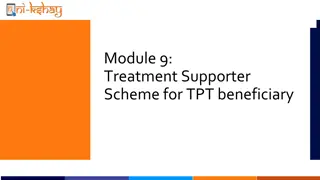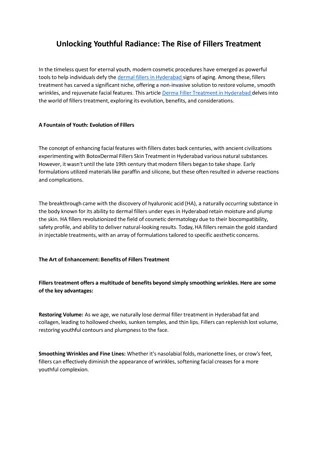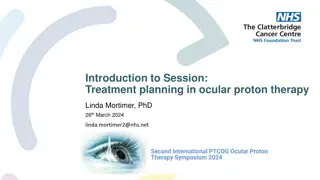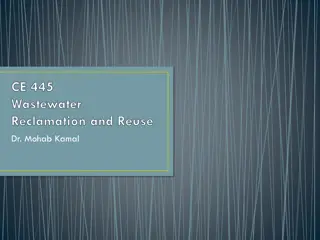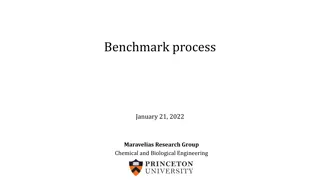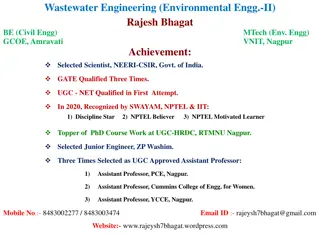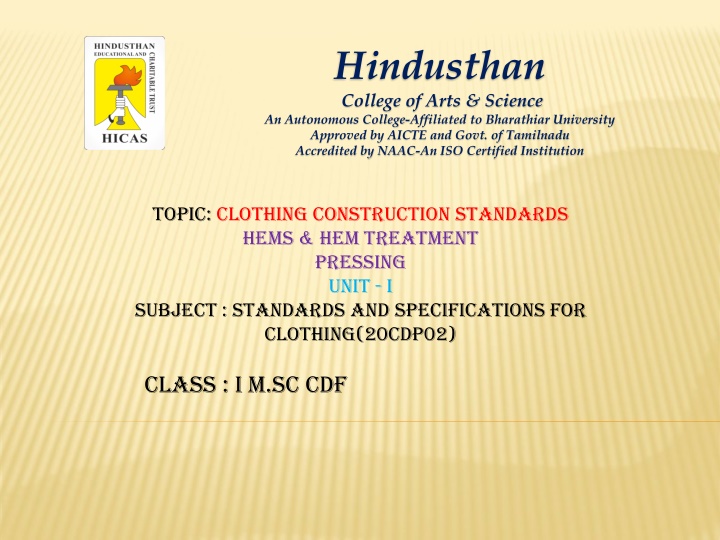
Clothing Construction Standards: Hems and Hem Treatments in Garment Finishing
Explore the world of hems and hem treatments in clothing construction standards. Learn about different methods for finishing garment edges, ensuring parallel hemlines, appropriate stitching techniques, and more to achieve a polished look in your clothing creations.
Uploaded on | 0 Views
Download Presentation

Please find below an Image/Link to download the presentation.
The content on the website is provided AS IS for your information and personal use only. It may not be sold, licensed, or shared on other websites without obtaining consent from the author. If you encounter any issues during the download, it is possible that the publisher has removed the file from their server.
You are allowed to download the files provided on this website for personal or commercial use, subject to the condition that they are used lawfully. All files are the property of their respective owners.
The content on the website is provided AS IS for your information and personal use only. It may not be sold, licensed, or shared on other websites without obtaining consent from the author.
E N D
Presentation Transcript
Hindusthan College of Arts & Science An Autonomous College-Affiliated to Bharathiar University Approved by AICTE and Govt. of Tamilnadu Accredited by NAAC-An ISO Certified Institution TOPIC: Clothing Construction Standards hems & hem treatment pressing Unit - i SUBJECT : STANDARDS AND SPECIFICATIONS FOR CLOTHING(20CDP02) Class : I M.SC CDF
HEMS AND HEM TREATMENTS Definition: Ahem in sewing is a garment finishing method, where the edge of a piece of cloth is folded and sewn to prevent unravelling of the fabric and to adjust the length of the piece in garments, such as at the end of the sleeve or the bottom of the garment
HEMS AND HEM TREATMENTS - A variety of methods is used to finish the lower raw edge of a garment. 1. The hemline of the garment appears parallel to the floor during wear, unless the garment design indicates an uneven hemline. 2. The hem is even in depth and appropriate for the weight of the fabric and the style of the garment. 3. The hem is flat and smooth, with no pulling, rippling, or puckering. 4. The hem type is appropriate for the garment's fabric, quality and style. 5. The hem finish is appropriate for the garment's fabric, quality and the type of hem.
6. The stitch which attaches the hem is appropriate for the garment's fabric, quality and style. Thread color matches the garment, and is not visible on outside of the garment. 7. Excess bulk has been eliminated from the hem area, i.e. fullness is reduced, and enclosed seams are pressed open and graded. 8. Topstitched hems are evenly stitched with the appropriate thread and stitch length. 9. Blind stitching, fusing, and gluing (leather) are inconspicuous on the right side of the garment. 10.Hems at the garment's opening(s) and vents are covered by the facing. 11.Hems in linings do not hang below the outer garment. 12.The stitch which attaches the hem in pleated hems catches the pleat crease.
DECORATIVE HEM The trim enhances the garment or makes it unusual in some way, without overpowering the garment's design. Soft Trims - Soft trims include items such as lace, braid, ribbon, piping, and bias binding. 1. The trim is suitable to the garment fabric's weight, design, and care requirements. 2. The trim is securely attached to the garment. 3. The trim is attached in an inconspicuous manner, unless the method of attachment constitutes part of the decorative effect flexible trim is used on curved areas and applied without stretching or puckering of the trim or the garment. 4. Trims used at the comers are mitered or appropriately applied to lie flat. 5. Bias binding and piping lie smooth with no rippling. See neckline treatments for more specific reference on bias binding. 6. There is no excess bulk at the joins or the ends.
Hard Trims - Hard trims include decorative items such as buckles, belts, studs, beads, and sequins. 1. The hard trim is compatible with the garment fabric's weight, style, and care requirements and will not damage the garment. 2. The hard trim is securely attached. 3. Beads, sequins, and studs are applied so that the fabric does not pucker, and the underside application is smooth. 4. Belts meant to be firm have a stiff backing which is securely attached and does not show on the face of the belt. 5. Belts do not rub off or bleed color onto the garments with which they are worn. 6. The belt buckle is securely attached to the belt and holds the free end of the belt securely when closed.
Fabric and Stitchery Trims - This category includes self-fabric and coordinating fabric trims such as ruffles and bows, appliqu s, and decorative stitchery. 1. Ruffles are neatly finished and smooth and have ample fullness, even gathers, and no puckers or pleats. 2. Appliqu s are securely attached to the base fabric, with no puckering, raveling or fraying apparent. 3. Fabric bows are neatly turned, with no seam wells and with symmetrical ends. 4. Fabric flowers are neatly finished with no raw edges and are securely attached. 5. Topstitching is an equal distance from the edge at all points. An appropriate stitch length is used, and all loose thread ends have been hidden. 6. Decorative stitchery does not distort the garment. 7. The thread used in the stitchery is colorfast. 8. Care requirements of the appliqu s and the stitchery are compatible with those of the garment.
Hems Appearance - flat, smooth, inconspicuous from right side unless decorative Ease - fullness in flared hem controlled with ease and shrinking Hand stitching - even, secure, free from drawing, inconspicuous; single thread used; stitches about 3/8" apart Pressing - upper hem edge should not imprint or cause ridge on outer garment Seams matched Topstitching - uniform, corresponds with other topstitching on garment; appropriate for garment Width - uniform; appropriate for fabric; style; provides enough weight to make garment hang well
Hems -Functions Flat and inconspicuous, unless meant to be decorative. Seams pressed as required and graded to reduce bulk. Hem fold pressed so hem hangs smoothly at lower edge. Hem edge smooth, flat, and free from raveling. Excess fullness evenly eased, free from pleats. Seams aligned. Hem edge finish should not create ridge or add bulk. Hem even in width. Width appropriate for garment style and fabric type. Topstitching is straight and attractive in size and placement. Hand stitches uniform, secure, and inconspicuous. Fused hems securely fused and flat. Hem hangs parallel to floor. Length attractive for wearer and appropriate for garment.
Edge Finishes -Types Unfininshed - appropriate for knit fabrics that do not ravel; finished with catch stitch or fusible web Edge stitched - appropriate for fabrics that ravel little; machine stitching 1/4" (6 nun) from edge; finished with catch or blind stitch or fusible web Seam binding - appropriate for all fabrics, especially those that ravel easily; binding compatible with fashion fabric and durable; overlaps hem edge by 1/4"; finished with blind or catch stitch
Edge Finishes -Types Hong Kong - appropriate for garments with relatively straight lines and interlined garments, provides bound edge; binding compatible with fashion fabric, straight and even application, finished with slip or catch stitch Faced - appropriate for use with bulky fabrics, if fabric is insufficient, as decoration effect, or to stiffen; appropriate facing material used; facing ends joined smoothly and without bulk; finished with slip stitch Serged overlocked- appropriate for all fabrics; stitching is flat and even
Edge Finishes -Types Faced - appropriate for use with bulky fabrics, if fabric is insufficient, as decoration effect, or to stiffen; appropriate facing material used; facing ends joined smoothly and without bulk; finished with slip stitch Serged overlocked- appropriate for all fabrics; stitching is flat and even
Types of Stitches Blindstitch - particularly suitable for medium and heavy-weight fabrics; top edge of hem folded back and stitching done 1/4" from edge; also called tailor's hem Catchstitch - particularly suitable for knit fabrics because it stretches; upper and lower rows of stitches are same distance apart; thread slightly loose. Slipstitch - desirable when stitching should be invisible from both sides of garment; stitches evenly spaced Topstitched - appropriate on narrow hems in sporty garments or as design detail when appropriate to fabric; appropriate thread, stitch length, and stitch pattern used; stitching straight, flat and even Machine blindstitch - appropriate for straight or very slightly flared garments of medium weight fabrics; only single thread of right side of garment caught by the offset machine stitch; stitching straight and even
Types of Stitches Catch Stitches Slip Stitches Blind Stitches Machine Blind Stitches Top Stitches
Special Hems Fused - appropriate on garments with relatively straight lines or narrow hem if very flared; inconspicuous on right side of garment; avoid on garments that may be dried at very high temperatures Lettuce leaf - appropriate only on stretch knits that do not run; decorative; hem allowance trimmed to 3/8" and turned to wrong side, stitched with medium zig-zag, or serged (no blade used) fabric stretched enough to produce desired curl Rolled - appropriate for sheer fabrics; finished width no more than 1/4" - preferably 1/8"
Importance of Edge Finishes An edge finish refers to the final hem you apply on the edges of a garment. It not only adds to its aesthetic appearance but prevents your garment from fraying on the edges over time. Edge finishing can be done using an overlocking/Serger machine if available, by hand or with a normal sewing machine
Uses of Edge Finishes to neaten the edge of the garment. to secure the edge and prevent fraying and raveling of fabric. to decorate an edge e.g. using bias binding for finishing necklines and armholes
A well-made hem should Be inconspicuous on the right side, except when it is a decorative part of the garment design. Be an appropriate distance from the floor. Be even in width and an appropriate depth for the fabric and garment design. Be free from bulk in seams that fall within the hem area. Have fullness eased in and evenly distributed for a smooth, flat appearance. Have an edge appropriately finished for the type and weight of fabric and hem stitch to be used. Be firmly secured with a hem stitch appropriate for the fabric and the hem edge finish.
Be neat with evenly spaced hand stitches 1 2 inch apart and with about 1 8 inch give (or have even machine stitching). Be lightly pressed. Hems are flat and even in depth without twisting or roping. Blind stitched and welted hems must have the correct depth of needle penetration to minimize strikethrough and the visibility of stitches on the outer fabric.
Standards Hem must be clean finished with double turn folder or guide & Single Needle Lockstitch Type Stitch through hem must have back tack of 3 Stitches, tolerance
PRESSING PRESSING
What is PRESSING ? Pressing is the application of heat, moisture and pressure maintaining actual time to give shape, mold, or crease on fabrics, garments, or garment parts into the geometric forms. Pressing is done for making the fabric smooth or to give it a perfect form. It is an important finishing process in apparel industry. Pressing or ironing is done during assembly or as a final finishing process
PRESSING 1. The garment surface is smooth and free from wrinkles. 2. The original appearance of the fabric has been maintained. It is: free from over pressing or iron imprints free from shine, scorching or melting free from flattened nap or pile free from imprints of construction details on the face of the garment free from stretching or shrinking free from water or mineral spots 3. Seams and darts are pressed smoothly on the stitching line; fabric does not fold over the stitching line or look bubbled. 4. Using shaped pads or boards, the shaping is pressed in where the garment will fit over body curves.
Categories of PRESSING 1. No pressing: Some garments are available; these are not need to pressing. Such as, underwear, briefs, swimwear. These types garments are made by knitted fabric. 2. Minimum pressing: Some garments are available; these are not needed finishing done by applying heat but no need pressing. Such as Night gowns knitted T-Shirt, Leisure wear and so on. These types of garments are pressing by steaming and by flowing dry air to the garments and called minimum pressing 3. Under pressing: To do help for sewing easily and beautifully, it must need to give minimum pressing to some parts of garments before sewing is called under pressing. Specially, under pressing is done to most of the garments industries for making coat, jacket, and trouser and so on. Sometimes, there is needed of unpicking and again under pressing is done before sewing.
Categories of PRESSING 4. Final pressing: These types garments are applying heat and pressing to the garments. This is done after making of garments. This is generally done in jacket, trouser, skirt and so on. Special type of pressing machine is used for final pressing. 5. Permanent pressing: Permanent pressing is a special type of pressing, when it is given to retain the shape of garments or special conditions. Such as, dart and pleat, which cannot be displace or drawn-off after washing of garments again and again. This type of pressing is done by applying high temperature and steam, sometimes, there is needed for pressing.
Purpose of PRESSING Removal of unwanted creases and crinkles: Different types of unwanted creases and crinkles are happened during making of garments. It may be forms due to the washing of garments. To remove these unwanted creases and crinkles from the garments, pressing or ironing is done. To apply creases where necessary: Sometimes, it is applied creasing effect to the garments to increase the beauty of that garments. Also, this is done before sewing to increase the beauty and proper sewing to the garments. These creases are applied by pressing. Shaping: Dart and seam are use to the garments for proper shaping to the wearer. To increase the beauty and attractiveness of created shape by using dart and seam is done by pressing. Sometimes it needs to shrink or stretch of garments parts for shaping, generally, pressing machine consists of a special type of bed is used for pressing.
Basic components of pressing: 1. Heat It is necessary to soften the fibres, stabilise in addition to laid the stuff inwards the desired shape. Temperature must live selected based on the fibres, yarns in addition to fabrics. 2. Steam (Moisture) It is fastest way of transmitting the estrus onto the fabric. Steam in addition to estrus are essential to repose the stuff from tension in addition to brand the stuff amongst adequate flexibility so that it tin dismiss live moulded to larn the required contour. 3. Pressure It is applied to modify the shape in addition to increment the durability of the moulding. Pressure could live applied past times way of a mechanical device or steam.
Basic components of pressing: 4. Drying Subsequent to the steam in addition to pressure level application on the fabric, the garment panel or finished garment must live dried in addition to cooled; thus, the stuff tin dismiss render to its regular wet content in addition to steady condition. This could live done past times removing the surplus H2O from the stuff past times way of a vacuum activeness which cools it at the same time. 5. Time The fourth dimension menstruum for which the garment is exposed to steam, pressure level in addition to drying depends on the type of stuff existence pressed in addition to at that spot volition live an optimal fourth dimension menstruum for each component.
Methods of PRESSING There are different types of pressing marching or equipment are using are given below: IRON At the ancient period, a small case, made by iron in which the heated coal and wood is used by burning and the garments are pressed by the lower smooth surfaces of case. At present, these coal and wood are replaced by electricity and this eclectic iron is widely used in household purpose. To control the temperature of electric iron, it is needed to control the regulator. For updating and to do easy, Iron is heated by supplying steam to the steam Iron. The steam inlet and outlet is controlled by a controlling switch provided in the Iron. For steam Iron, special air suction bed is used to control the unexpected crease on garments. This is triangular in shape and weighted from 1 to 15 kegs.
Steam Press This contains a static buck and a head whose are shaped with each other. The fabric is placed on the buck and the head is placed then on it and pressing is done by applying heat and pressure. The ironing bed is made by spreading the layers of fabrics on the buck which is placed in a frame. There is provided air suction and steam flow system through the buck. The table is placed around the buck on which fabric is placed
STEAM AIR FINISHER This type of garments finishing machine is known as puffer or dolly press. The dolly press contains a frame which contains form and the steam and compressed air are flowed by pipe through the form. The pressing form is generally made by heavy canvas fabric. There is no sleeve and the usable form size is made according to the size of body of garments. Steam and air are supplied for a predetermined time by using a timer. Normally 8 seconds for steam supply and next 8 seconds for hot air supply. This type pressing is used for pressing T-shirts, jeans, pants, blouses, and sportswear and so on.
STEAM TUNNEL In this process garments are pressed without any pressure. Garments are hung on hanger and pushed into a tanner containing separate chamber through a running rain. Garments are heated on first chamber and unexpected crease is removed from fabric by relaxation and gravitational force. Garments are dried by hot air in the 2nd chamber. This type of pressing is used for pressing T-shirts and knitted wears
Pressing -Advantages Garment smooth and free from wrinkles. Free from sheen and scorch. No ridges from seams or facings. Seams pressed flat and inconspicuous. Darts pressed to shape of garment. Pleats, tucks, and creases pressed, as design requires.
Pressing Appearance - smooth, free from wrinkles; original appearance of fabric maintained: no overpressing; no sheen; no flattened nap or pile; no imprints of construction details on outside; no stretching or shrinking; no water spots Curves - shaping pressed in Done throughout construction
Importance of Pressing When pressing, you get that polished look with seams that lay flat, like store-bought clothing. It also gives you an accurate cut when your seams and creases are carefully pressed. Pressing seams is extremely important before you sew another seam that is going to cross it.
A well-pressed garment should: Maintain the original texture of the fabric. Show no shine or press marks on the right side of the fabric. Have no wrinkles or crinkled areas. Have seams and darts pressed smoothly on the stitching line, so that the fabric does not fold over the stitching line or look bubbled. Edges of seam allowances and fold edges of darts do not form ridges on the right side of the garment. Have no water-spot or steam marks. Help create and maintain the proper shape and curve to the garment and the various garment segments (collar, sleeve, etc.).
Standards The following is unacceptable when pressing garments: Creasing, glazing and harsh pressing. Pressing marks.
A V https://www.youtube.com/watch?v=5vL6BczNe6I



